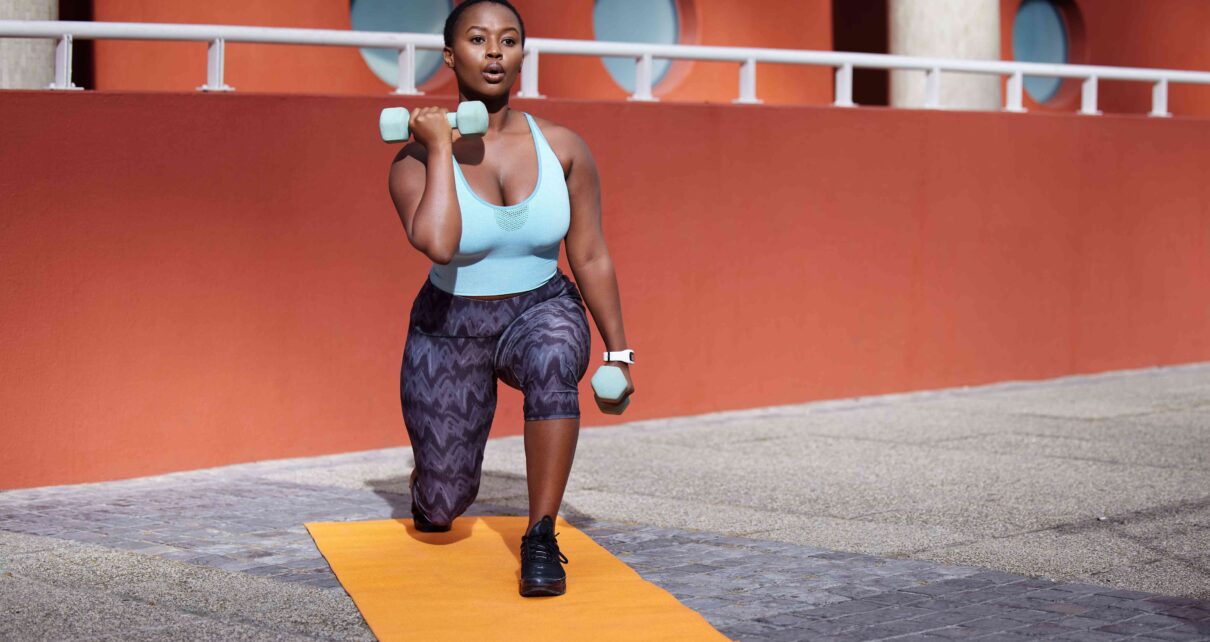
Strength training: “how weight training will transform your body and strengthen your mind”
Posted by Alix Walker for Life
The appeal of strength-training has grown fast over the last few years, as more and more of us discover the health benefits of working with weights. Stylist’s Alix Walker took part in some weight-training of her own – and discovered the benefits aren’t purely physical, but mental, too.
Until last November I had never strength trained, and only ever entered a gym to lose weight. Body Pump classes and their familiar smell of trainer sweat and resentment were only suffered if I had an impending beach holiday.
But walking home one night last autumn, I passed a group of men and felt the familiar pang of vulnerability. I wouldn’t fancy my chances fighting off a chihuahua, never mind a real threat. And whether it’s personal growth or an ever-so-slowly shifting mindset around female body shapes, I started thinking it would be nice to actually feel strong; to give myself a fighting chance. At the very least it might make carrying home my Zara haul easier. So, I decided once again to change my body – only this time, I didn’t want to make it smaller, I wanted to make it stronger.
You may also like
Strength training: 3 female personal trainers transforming the way we exercise
Today #girlsthatlift has 4.5 million posts on Instagram; #strongnotskinny has 9 million; and strength training (the use of resistance – usually heavy weights – to build muscle strength and size) was declared 2018’s top fitness trend by ClassPass in the US. Yet just a few years ago strength and resistance training was, for the most part, a man’s world (in 2011 just 0.9% of women lifted heavy weights). Women were directed to the other side of the gym where we sweated through aerobics.
But – thank god – this has been shifting rapidly over the past few years. Most gyms now offer some form of strength-focused class – and I know three women who compete in weight-lifting competitions at the weekend. But no doubt the biggest catalyst for the huge uptake is the fact that strength training works.
In 2019, we launched Stylist Strong, a female-focused fitness space with workouts designed to help you increase your strength – whether that’s beating a personal best or getting stronger for everyday challenges. The more I listened to what the classes were like, the more I knew this was what I’d been looking for.
And so I began my strong mission. I asked Virgin Active to set me up with one of their personal trainers, Raphael Vittori Cray, who would coach me three times a week concentrating on legs, back and biceps, chest, shoulders and triceps.

Raph began by assessing the upper limit of how much I could lift, which we would re-test every month to see how my strength was improving. The first session proved I was far from strong as my legs wobbled manically on my second set of walking lunges, but I could already do more than I had anticipated (a particular high point was asking for the next weights up on the leg press machine) and although I’d used a lot of physical effort, I never felt exhausted (like I do if I’m running), or mind-numbingly bored (like I do if I’m running). In fact, I finished the session feeling pretty triumphant because I genuinely didn’t hate it – a first! – and I hadn’t given up on a lift, regardless of the burn.
After the pre-requisite high five (high-fiveing is huge in gyms, it seems), I turned to Raph and half-whispered: “Just one thing I should have mentioned, I don’t really want to get bulky…”
Unless you’re going to live at the gym and eat nothing but steak, you won’t get bulky.
The bulk myth
Ah, yes. Bulk. The well-toned elephant in the room. The powerful association of heavy weights with thick necks and He-Man shoulders. Every expert I spoke to for this feature said this was both the primary concern and biggest misconception about strength training, but, as Raph reassured me, “Unless you’re going to live at the gym and eat nothing but steak, you won’t get bulky.”
Of course, our notion of what constitutes ‘bulky’ in a woman is changing as the ridiculously narrow standard of what a female body shape should look like – long, lean and toned but never muscly – gets a long overdue overhaul. The bottom line is: gaining a significant amount of muscle mass is extremely difficult for the vast majority of women (experts estimate a maximum of 1lb of muscle per month which will reduce the longer you train). Men also produce 20 times more testosterone – the primary hormone needed for muscle growth – than women.
So why are women reclaiming this previously male territory? “I started strength training about three years ago,” says journalist Poorna Bell, who has just deadlifted 125kg at a powerlifting competition. “My husband passed away and I needed a goal to work towards. I had relied on him to do certain things because, as a man, he was stronger – moving furniture, flipping the mattress – and I didn’t want to feel reliant on anyone. I instantly loved it because you can quantifiably say you’re stronger when you see the numbers on the weights going up. Suddenly, your newfound ability replaces the previous motivation to look lean or lose weight.”

There’s no doubt it’s become a much more visible activity since female weightlifters like Zoe Smith won her first Commonwealth medal in 2010 and the all-female British weightlifting squad was formed in June 2014. But it’s also due to changing attitudes as exercise becomes more about empowerment, health and wellness rather than simply the size of our body.
The health benefits are pretty appealing too. In 2018, a study by the University of Michigan found a link between stronger muscles and increased life expectancy. And it’s particularly important for women as it protects us against osteoporosis, a condition which sees bones weaken and disproportionately affects women (80% of sufferers are female). Numerous studies have shown that strength training can play a role in slowing bone loss, and several show it can even build bone.
The other clear benefit of strength training is that muscle burns more calories than fat, even at rest, meaning, in simple terms, that it’s potentially far more effective than cardio for weight loss, if that’s your motivation. And if you need more convincing, a 2016 study suggested that strength training may lower a woman’s risk of Type 2 diabetes and cardiovascular disease.
No pain, no gain
By the end of week two my body already felt tighter – the fastest results I’ve ever seen in my admittedly exercise-lite life. One thing I was struggling with, however, was DOMS (delayed onset muscle soreness) as I learnt after googling why my legs were permanent balls of fire at 3am. “The soreness you’re experiencing shows your fitness is progressing,” says creator of the Stylist Strong programme, Nike’s Global Master Trainer Joslyn Thompson Rule, who is passionate about seeing more women strength training after seeing the huge benefits it’s given her. “If it continues to be a problem, you need to look at your sleep, food intake and whether you’re staying hydrated.”

I also spoke to registered sports nutritionist (and former British bodybuilding champion) Anita Bean, who explained how vital it is that you make minor dietary changes too. “You need to ensure you get enough fuel and nutrients to facilitate muscle adaptation,” she explains. Did that mean carrying three roast chickens around with me? Not quite. “If you’re strength training, you’ll need around 1.2 to 1.8 grams of protein per kilogram of body weight per day. That’s basically double the amount of a sedentary person.The other thing to consider is timing. Eat around 25g of protein before you train for maximum muscle gains, then 25g after training, along with carbohydrates, to fuel recovery. I’d suggest fuelling for a workout with 250g of Greek yoghurt, a small chicken breast, 100g of fish or half a tin of beans plus cooked quinoa.”
You may also like
Strength training: 5 best weight machines to use in the gym
So I began eating protein with every meal – nothing over-the-top: Bircher muesli for breakfast, chicken wrap at lunch and fish for dinner. It didn’t eradicate the pain completely – leg days are always killer – but it definitely helped.
Two months into my training I went away on holiday and my youngest daughter – a two-stone lump – decided the only way she would travel was scooped up in my left arm. I carried her for miles with relative ease. It was then I clocked the impact my training was having on everyday activities. I had way more energy too, most likely because I was sleeping like a dream (a proven side effect of strength training). Raph confirmed it wasn’t just my imagination the day after I got home. “You’ve just done walking lunges with twice what you were lifting a month ago.”
After decades of finding gyms dominated by masculine energy, I’ve found my space alongside women who are motivated by strength, health and camaraderie
Strength of mind
I felt bloody elated. With what felt like fairly minimal effort on my part, I was categorically stronger. And while I loved the newfound definition in my arms, it was my mind where I felt the most progress.
My husband brought it up first, saying, “Don’t give this up. You seem happier.” And it was true. I felt calmer, more positive but also more disciplined – I was far more productive at work and I actually called our broadband supplier to change plans, which had been on my to-do list for approximately five years.
The mental health benefits of strength training are still being investigated but there have been some fascinating studies so far. The University of South Carolina found that women who did twice-weekly resistance training had a 60% decrease in anxiety levels and lowered levels of irritability in six weeks. And a review of 25 randomised controlled trials looking at exercise and depression found that strength training had twice the mood-boosting benefits of aerobic exercise alone (though the best result was when patients did both).
“There are a number of mechanisms we think are at work here,” says Dr Claire-Marie Roberts, a sports psychology lecturer at the University of the West of England. “The first one at play is the neural system adaptation to strength training. Your muscles adapt to being placed under physical stress, which extends to your brain, meaning we’re not just training our biceps, but our brains too.
“It also aids activity-induced neurotransmitters like serotonin, which make us feel good. Finally, there’s the more psychological side where you set yourself a goal – to lift a certain weight, for example – and the instantaneous feedback of reaching it increases your level of self-esteem.”
One thing I had no idea about before I started training was that after every set you rest for 90 seconds. It’s an enforced yet productive breather that completely contradicted my ‘never stop’ approach. I felt like a fraud at first but as my kettlebell weight kept increasing – 5kg, 10kg, 15kg, 20kg – I realised there really is something to be said for slowing down. Over time those tiny breathers became almost meditative, pockets of time to focus on nothing but my breathing and psyching myself up for the next set. It had a real impact on how I work and I now give myself little concentration breaks rather than plough on.
While I loved the newfound definition in my arms, it was my mind where I felt the most progress.
Alix’s Stats
NOVEMBER 2018:
Deadlift: 30kg
Chest press: 5kg each side
Bench press: 25kg
Overhead lunge: 15kg
Walking lunge: 6kg
MAY 2019:
Deadlift: 40kg
Chest press: 10kg
Bench press: 30kg
Overhead lunge: 20kg
Walking lunge: 12kg

Six months later, strength training has become as important to me as my Netflix subscription. After decades of finding gyms dominated by masculine energy, I’ve found my space alongside women who are motivated by strength, health and camaraderie (when I did a 40kg deadlift for the first time four months after I started I was surrounded by women shouting “You can do it!”).
I don’t look that different – I think people are disappointed I’m not a modern-day She-Ra – but do not underestimate anyone who strength trains, because the size of your body has very little to do with your ability to lift heavy, and isn’t that exactly how it should be?
“The best thing for me is when I’m training a group of women and they realise that they can lift that weight, that their body can do this,” says Thompson Rule. “They think, ‘This is me, this is what I can do and no one can stop me’.”

Follow @StrongWomenUK on Instagram for the latest workouts, delicious recipes and motivation from your favourite fitness experts.






